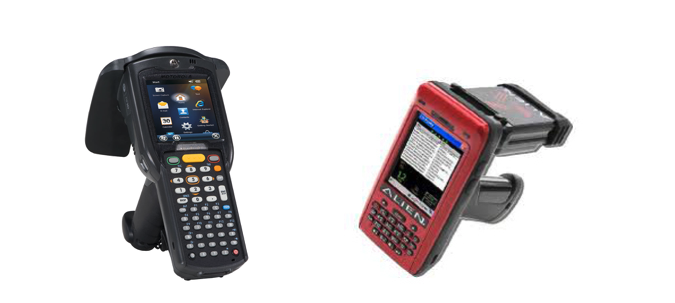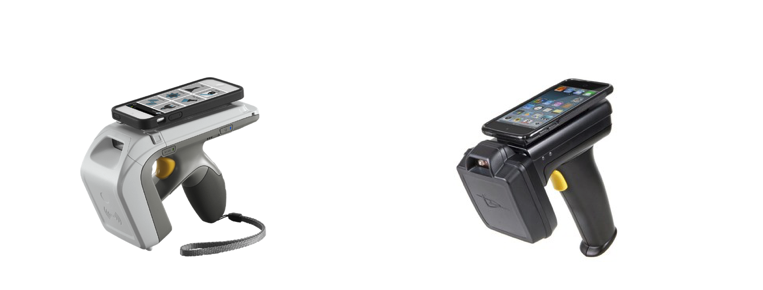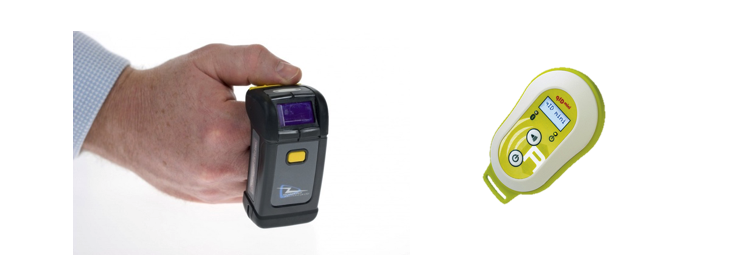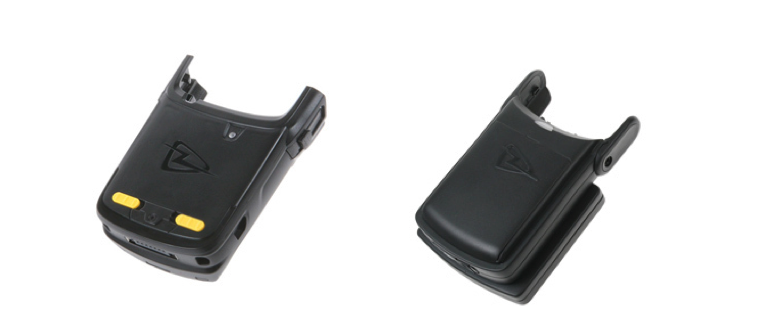How to Select an RFID Handheld
There are many choices on the market and the more choices the harder it is to pick out the right device for your application and budget.
If you can't bring the asset to the reader like with a conveyor or a door portal processing, you have to bring the reader to the asset. Handheld readers are typically used for exception processing, asset tracking when asset is fixed, remote data collection, and in small scale installations. There are four main types of handheld readers:
- Handheld Computers
with RFID Capability – these devices have an onboard computer usually with
Windows OS, display, keyboard and of course RFID antenna and reader. These devices
are usually the most expensive, however, they pack the most functionality and
usually can be custom configured with options based on your needs. For
instance, you can add a 1D barcode scanner or 2D Imager, camera, Bluetooth
communication, more memory and other options.

- Sled Handheld Readers – sleds are becoming increasingly popular,
because instead of having a built-in computer on board, they utilize a smart
phone. They only house the RFID reader, antenna, handle with a trigger and
connection to the smart phone. The smart phone runs an app and communicates
with the sled reader and with the network over Wi-Fi or Bluetooth. Because of
using smart phone, Android, iOS or Windows apps can be easily utilized. Sleds
can also have variations including barcode scanning. This option is also more
cost effective. Good examples of popular sleds are Zebra RFD8500
and TSL 1128.

- Bluetooth Handhelds – The third type (not really an official
category) are small readers that are in form of a keyfob or strap on your hand
or belt. They usually don’t have a display or maybe a very small LCD one,
include RFID reader and antenna and communicate with your smart phone over a
Bluetooth. These readers are perfect where space is an issue and users need
small and light device. Such handhelds are usually the most cost effective,
however, due to their small size, they usually have quite short read range and
shorter battery life. Great examples are CAEN qID Mini Keyfob Reader and TSL 1153 (UHF).

- RFID Handheld Snap-Ons – this is a category of add-on modules that can
be plugged into existing non-RFID handheld computers. These are often HF and LF
frequency, but there are some UHF as well. This is a good option, if you
already have handheld computers on-site that you use and you can enable them
with RFID for a relatively low cost instead of replacing them. The
cost depends on whether the snap-on has its own battery therefore not draining
the battery life of the handheld unit itself or whether it uses the handheld
power.

Handheld Selection Criteria:
- Frequency – based on your tags - LF, HF, UHF
- Protocol – based on your tags - HF - 14443, 15693, NFC, Mifare, etc., UHF – Class 1 Gen 2
- Regulatory compliance – depending on country of operations
- Processing
- Fully onboard
- Sled – using a smart phone
- Keyfob or Bluetooth reader – using a smartphone
- Size
- Larger – handheld computers, sleds, handheld snap-ons
- Small – keyfobs, Bluetooth readers
- Read Range
- Longer – handheld computers, sleds
- Shorter – snap-ons, keyfobs, Bluetooth readers
- Keyboard – yes, no, how many keys, layout
- Display – yes, no, how large, color or monochrome
- Battery size and how many hours of operation
- Charging convenience
- AC Charger
- Car charger
- USB cable to computer or charger
- Cradle – single unit, multiple unit
- Separate battery charger
- Network options – USB, Wi-Fi, Bluetooth, ActiveSync
- Additional Options
- Barcode scanner – 1D Laser, 2D Imager
- Extended life battery
- Camera
- Extended Memory
- Light indicators – for charging, reading, error, off
- Ruggedness – manufactures usually provide information on how many drops to concrete from how far the unit withstands (i.e. multiple 4 ft./1.2 m drops to concrete across the operating temperature range), tumble specifications (i.e. 500 1.64 ft./.5 m tumbles (1,000 drops) at room temperature), as well as IP rating and other parameters.
- Warranty – standard manufacturer’s warranty, options for extended warranty
Note: When ordering a handheld reader, review items that are included in the package, which differ by manufacturer and sometimes by the part number. For instance, sled readers do not automatically come with the holder for a smart phone as those are phone specific and must be ordered separately. No readers usually come with a cradle, although most will come with at least an USB or minimal charging cable and one battery.
Recent Posts
-
What's the difference between Direct Thermal and Thermal Transfer RFID Labels?
In industries such as logistics, retail, and healthcare, RFID (Radio Frequency Identification) techn …Mar 20th 2024 -
Use Cases Where TagMatiks Rugged Tags can be used
What if a machine, construction tool, or cargo container has a standard RFID tag affixed to its e …Mar 19th 2024 -
Exploring the RFID Tag and Label Sample Packs Offered by RFID4UStore
Radio Frequency Identification ( RFID ) is becoming more and more essential in a variety of ind …Mar 15th 2024




